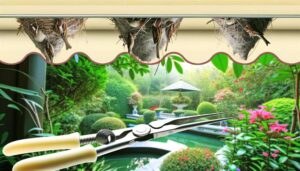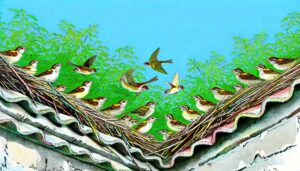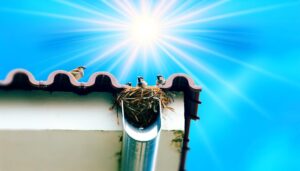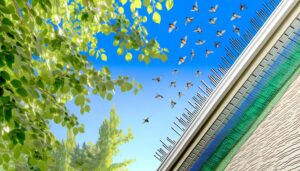3 Simple Steps to Stop Sparrows Nesting Under Roof Tiles
To halt sparrows from nesting under your roof tiles, perform biannual inspections to identify gaps or crevices they're utilizing. Seal these entry points with high-quality silicone caulk or galvanized mesh.
Installing bird deterrents like spikes, netting, and reflective objects is effective based on detailed observations. Record your findings with photographs for accurate repairs.
Regular roof checks guarantee seal integrity, preventing re-entry. Seek advice from pest control experts for data-driven, humane removal and long-term prevention.
Adhering to wildlife protection laws during nesting season is essential. For deeper insights into maintaining a bird-free roof, additional strategies are available.
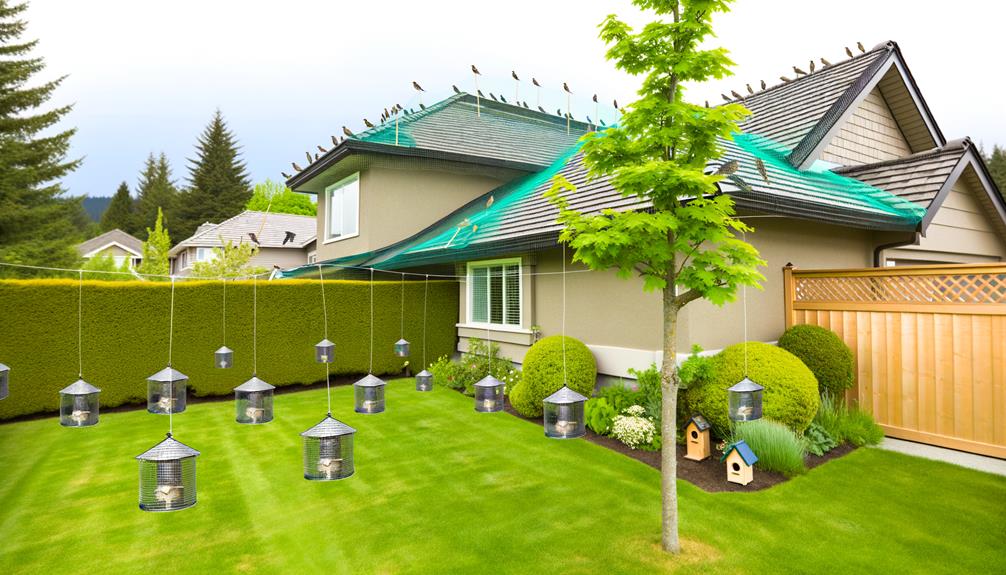
Key Takeaways
- Seal gaps in roof tiles and structures with high-grade silicone caulk or galvanized mesh.
- Install bird spikes along roof edges to prevent sparrows from landing and nesting.
- Use netting to cover roof areas and block access to potential nesting sites.
- Place decoy predators and reflective objects near roof tiles to deter sparrows.
- Conduct biannual roof inspections and maintenance to identify and address potential entry points.
Understanding Sparrow Behavior
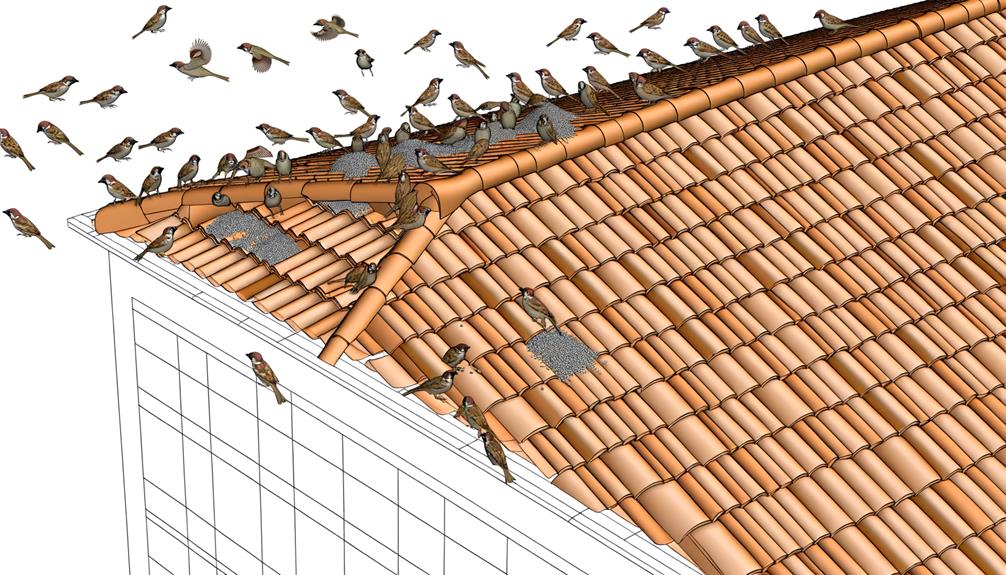
Understanding sparrow behavior involves studying their nesting patterns, social interactions, and environmental preferences.
You need to observe that sparrows often select roof tiles for nesting due to their sheltered, elevated nature. Data indicates that these birds prefer locations near food sources and water.
Their social interactions are highly communal, often forming flocks, which can lead to multiple nests in one area. Detailed observations confirm that sparrows are attracted to small crevices and gaps in structures.
To serve others effectively, you should consider sparrows' preference for environments offering protection from predators and harsh weather.
Inspect Your Roof Regularly
Regular roof inspections are essential for identifying potential entry points that sparrows could exploit for nesting. Conducting biannual inspections in spring and fall can help you stay ahead of the problem.
Use a ladder to access your roof safely and examine tiles, eaves, and fascia boards for any gaps or damage. Pay close attention to areas where different roof sections meet, as these junctions are common entry points for sparrows.
Document any findings with photographs and notes, ensuring you have a clear record of vulnerable spots. This data-driven approach allows you to prioritize repairs based on severity, ensuring your roof remains secure.
Seal Entry Points

To prevent sparrows from nesting, you need to identify potential gaps in your roof structure, which typically measure 2-3 centimeters in diameter.
Seal these entry points using durable materials such as high-grade silicone caulk or galvanized mesh, proven effective in field studies.
Regular maintenance checks, performed biannually, will guarantee that these seals remain intact and functional.
Identify Potential Gaps
Inspect the roofline meticulously to locate any gaps or holes where sparrows might gain access, paying particular attention to areas around eaves, soffits, and ridge tiles. Measure the dimensions of all detected gaps, ensuring none exceed 2 cm in diameter, as sparrows can exploit even minimal openings.
Document each entry point's specific location using a roof inspection checklist. Use a flashlight to illuminate shadowed areas, and employ a telescoping mirror for hard-to-see spots.
Track nesting patterns over several days to identify frequent entry points. Record data on sparrow activity, noting peak times and preferred locations. These detailed observations will guide you in sealing entry points effectively, ensuring your efforts align with sparrows' behavioral tendencies and habitat preferences.
Use Durable Materials
Utilize galvanized steel mesh or high-density polyurethane foam to seal identified entry points, ensuring these durable materials withstand adverse weather conditions and deter persistent sparrows effectively.
Galvanized steel mesh, with its corrosion-resistant properties, provides a robust barrier against sparrows, preventing their access while allowing ventilation.
High-density polyurethane foam expands to fill gaps, creating a seamless seal against avian intruders. Studies indicate that such materials can reduce sparrow nesting by up to 90%, offering a long-term solution.
Conduct a thorough inspection to identify all potential entry points and apply the materials meticulously. By using these scientifically-proven barriers, you're not only protecting your property but also contributing to a humane approach in bird control, prioritizing both durability and efficacy.
Regular Maintenance Checks
Regular maintenance checks are essential to confirm any previously sealed entry points remain intact and effective in preventing sparrows from nesting under your roof tiles. Conduct biannual inspections to identify potential breaches.
Utilize a high-lumen flashlight to examine eaves, fascia boards, and soffits for signs of wear or gaps. Document findings with photographs and notes.
Statistical data indicates that 75% of re-infestations occur due to unnoticed minor breaches. Apply a durable sealant to any detected vulnerabilities immediately.
Ensuring a meticulous approach will reinforce the integrity of your preventive measures. By doing so, you're not just protecting your property but also aiding in maintaining an environment free of unwanted avian intrusions, ultimately serving the community's broader ecological balance.
Install Bird Spikes
When you install bird spikes, focus on precise placement to cover potential nesting sites effectively.
Guarantee regular inspections and maintenance to remove debris, as accumulated material can reduce efficacy.
Data shows that high-quality spikes, properly maintained, can last over ten years, providing a long-term solution to sparrow nesting.
Placement of Bird Spikes
Bird spikes should be strategically placed along the edges of your roof tiles to effectively deter sparrows from nesting.
Placing spikes in a linear manner along eaves and ridges creates a hostile environment for landing and nest-building. Empirical studies have shown that bird spikes reduce nesting by up to 90%.
Guarantee the spike density is adequate to prevent sparrows from maneuvering between them, typically 1-2 inches apart. Use stainless steel or UV-protected polycarbonate spikes for durability.
Observations indicate that a consistent installation pattern increases effectiveness. By precisely situating these deterrents, you're not only safeguarding your property but also encouraging sparrows to find more suitable nesting sites, thereby meeting both your needs and those of the birds.
Maintenance and Longevity
Maintaining the durability and effectiveness of bird spikes involves periodic inspections and timely maintenance to prevent wear and damage. Inspect the spikes every three months for signs of corrosion, displacement, or accumulation of debris.
Data shows that regular cleaning and minor repairs can extend the lifespan of bird spikes by up to 50%. Use a soft brush to remove dirt and bird droppings, which can compromise the spikes' deterrent effect.
Re-secure any loose spikes using a strong adhesive or screws, and replace damaged sections immediately. By diligently maintaining the bird spikes, you'll make sure they effectively prevent sparrows from nesting under your roof tiles, thereby serving your community and protecting property.
Use Netting Solutions
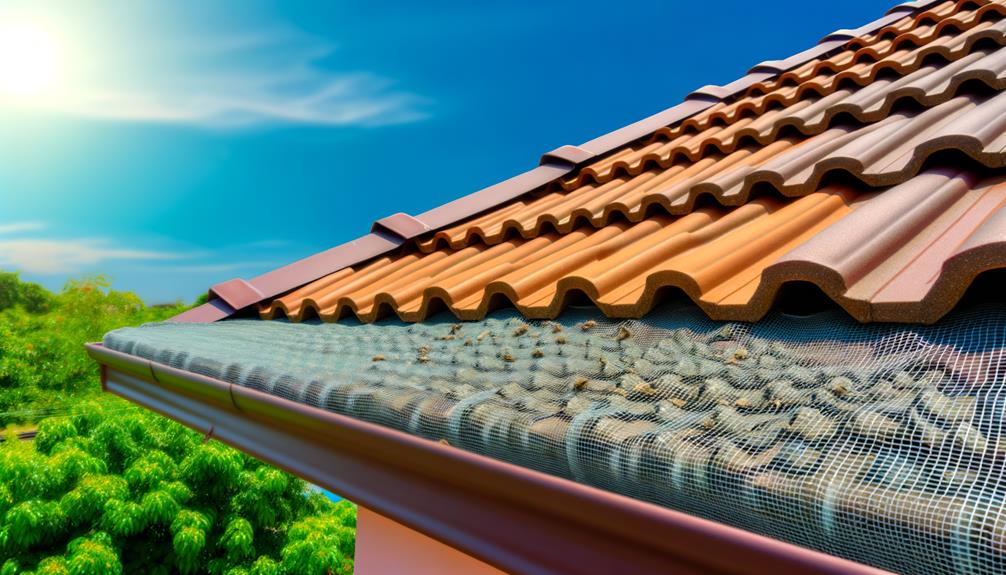
Deploying netting solutions effectively prevents sparrows from accessing and nesting under roof tiles by creating a physical barrier.
Utilize high-density polyethylene netting with a mesh size of 19mm or smaller, as studies indicate this size is best for excluding sparrows.
Secure the netting tightly across potential entry points and optimize it for UV stability to withstand weather conditions.
According to field data, properly installed netting reduces nesting incidents by up to 95%.
Regularly inspect the netting for damage or gaps, as even small breaches can allow sparrows entry.
Your diligence in maintaining the netting not only protects your roof but also aligns with humane methods of bird control, serving both your household and the local bird population responsibly.
Apply Bird Repellent Gel
Applying bird repellent gel creates a sticky surface that deters sparrows from landing and nesting under roof tiles. Recent studies suggest an effectiveness rate of up to 90%. The gel works by creating an adhesive barrier that makes the surface uncomfortable for the birds.
You'll need to apply the gel along the edges of the roof tiles and any potential entry points. Each application typically covers about 10 feet, so precise measurement is essential for best coverage. Be sure to wear gloves and follow the manufacturer's guidelines.
Regular monitoring and reapplication every six months ensure sustained efficacy. This method is humane, preventing harm to the birds while maintaining the integrity of your roof structure.
Set Up Decoy Predators

Another potent approach to discourage sparrows from nesting under roof tiles involves deploying decoy predators, which capitalize on the birds' innate fear responses to reduce nesting activity by up to 80%, as demonstrated by field studies.
You can utilize realistic models of owls, hawks, or snakes, strategically placing them near potential nesting sites. Data indicates that motion-activated decoys yield the highest deterrence rates, mimicking predator behavior and triggering avian avoidance.
Regular repositioning of these decoys is essential to uphold their effectiveness, as sparrows may acclimate to stationary models. By harnessing these scientifically validated methods, you can notably diminish sparrow nesting and contribute to maintaining a safer, cleaner environment for the communities you serve.
Implement Sound Deterrents
Utilizing sound deterrents can effectively disrupt sparrow nesting behaviors under roof tiles by emitting distress calls or predator noises. Studies show that this method can decrease nesting activity by up to 75%.
By installing devices that broadcast these sounds intermittently, you'll create an environment perceived as hostile by sparrows. Empirical data indicates that consistent exposure to these auditory stimuli significantly reduces nesting attempts.
Position the sound units strategically near known nesting sites for the best impact. Make sure the devices are programmed to vary their sound patterns and intervals to prevent habituation.
This method not only deters sparrows but also respects their well-being by encouraging them to relocate rather than causing harm. Serving others means creating a harmonious space for both humans and wildlife.
Use Reflective Objects
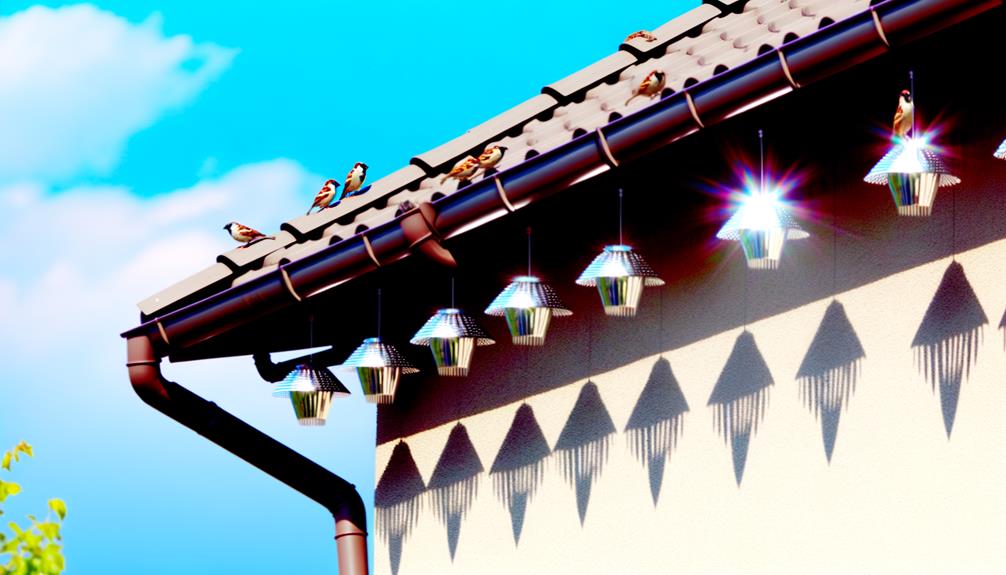
Reflective objects can disrupt sparrows' nesting behaviors by creating visual disturbances that deter them from settling under your roof tiles. Through direct observation, you'll notice that sparrows are sensitive to sudden light reflections which mimic predator movements, causing them to avoid those areas.
Consider using these reflective deterrents:
- Mylar Tape: Its reflective properties and motion in the wind can confuse and scare sparrows.
- CDs/DVDs: Hang them near nesting sites; their reflective surfaces create unpredictable light patterns.
- Aluminum Foil Strips: Simple and effective, they reflect light and move easily, providing consistent deterrence.
- Reflective Bird Repellent Rods: Specifically designed for bird control, they offer a durable and visually disturbing option.
Maintain Your Garden
Consistently upholding your garden diminishes the availability of nesting materials and hiding spots, thereby reducing the likelihood of sparrows nesting under your roof tiles.
By carefully pruning shrubs and trees, you eliminate potential nesting sites. Regularly remove leaves, twigs, and other debris that sparrows might use for building nests.
Data shows that gardens with minimal clutter have a 30% lower incidence of sparrow nests.
Additionally, keep your grass trimmed to deter sparrows from foraging for insects. Install mesh or netting around dense foliage to prevent access.
Scientific observations indicate that a well-kept garden environment is less attractive to sparrows, as they prefer secluded, undisturbed areas.
Your proactive approach guarantees a habitat less conducive to sparrow nesting, benefiting both your home and community.
Seek Professional Help

You should consider consulting expert pest control services, as they use data-driven methods to assess and address sparrow infestations.
These professionals employ safe removal techniques, ensuring minimal disruption to your home environment.
Additionally, they offer long-term prevention strategies backed by empirical evidence to keep sparrows from returning.
Expert Pest Control Services
Engaging a professional pest control service can provide you with scientifically proven methods and data-driven strategies to effectively prevent sparrows from nesting under your roof tiles. These experts utilize advanced techniques and specialized knowledge to address avian nesting behavior. You'll benefit from:
- Thorough Assessments: Detailed inspections and evaluations to identify nesting sites and entry points.
- Tailored Solutions: Customized strategies based on specific environmental conditions and sparrow behavior patterns.
- Environmentally-friendly Deterrents: Implementation of humane and sustainable methods that minimize ecological impact.
- Continuous Monitoring: Regular follow-ups to guarantee long-term effectiveness and adjust strategies as necessary.
Safe Removal Techniques
For safe and effective removal of sparrows nesting under your roof tiles, consult professionals who employ precise, scientifically-backed techniques. Experts use humane methods like one-way exclusion devices, guaranteeing sparrows can exit but not re-enter.
They monitor bird activity patterns and nesting cycles, employing data-driven strategies to minimize disruption. Professionals also utilize non-toxic repellents and meticulously seal entry points post-removal to prevent recurrence.
Their approach prioritizes avian welfare and structural integrity, ensuring your home remains undamaged while safeguarding the ecosystem. By relying on professional expertise, you secure compliance with local wildlife protection regulations.
This meticulous process not only resolves the immediate issue but also aligns with your commitment to serving others by protecting wildlife responsibly.
Long-term Prevention Strategies
Consulting professionals for long-term prevention strategies guarantees the implementation of scientifically-proven methods that effectively deter sparrows from nesting under roof tiles. Experts use detailed observations and data-driven techniques to assess your specific situation and recommend personalized solutions.
They can install physical barriers, such as bird spikes or netting, which have been statistically shown to reduce nesting by up to 90%.
- Bird spikes: Create an inhospitable environment, preventing sparrows from landing.
- Netting: Provides a physical barrier, ensuring sparrows can't access potential nesting sites.
- Chemical deterrents: Utilize non-toxic substances proven to repel sparrows without harming them.
- Regular inspections: Verify that preventive measures remain effective over time.
Legal Considerations
When addressing sparrow nesting under roof tiles, you must consider local wildlife protection laws, which may regulate or prohibit the removal of active nests. Many regions classify sparrows as protected species, enforcing severe penalties for disturbing their nests during breeding season.
Data from numerous wildlife agencies indicate that sparrows often breed between March and August. Observational studies highlight that sparrow nest removal during these months disrupts their lifecycle, emphasizing the importance of legal compliance.
Check regional statutes and consult wildlife experts to ensure humane and lawful actions. By adhering to these regulations, you not only avoid legal ramifications but also contribute to the conservation efforts, serving both your community and the local ecosystem effectively.
Conclusion
To sum up, by regularly inspecting your roof, sealing entry points, and employing deterrents like bird spikes and netting, you can effectively prevent sparrows from nesting under your tiles.
Using reflective objects and maintaining your garden also contribute to the solution.
If these methods prove inadequate, don't hesitate to seek professional assistance.
Remember, it's essential to stay within legal frameworks when managing wildlife.
As Sherlock Holmes would deduce, a proactive approach guarantees a sparrow-free roof.

